How Well Can an Electric Pickup Truck Tow?
CR’s testing reveals how well the Ford F-150 Lightning and Rivian R1T can handle a heavy trailer, and the challenges of long-distance towing
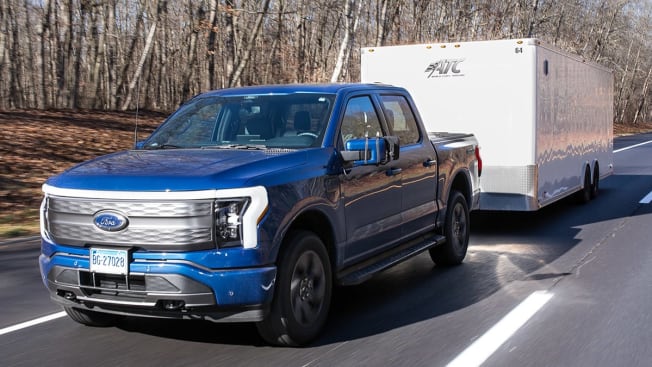
Full-sized pickup trucks can do double duty as work trucks and as a substitute for the family car. They are big, powerful, and versatile. But they are also thirsty. Switching to an electric pickup brings significant fuel cost savings along with major reductions in tailpipe emissions. EV trucks can even provide a convenient electricity source when camping or on a job site.
But are electric pickup trucks suitable for towing?
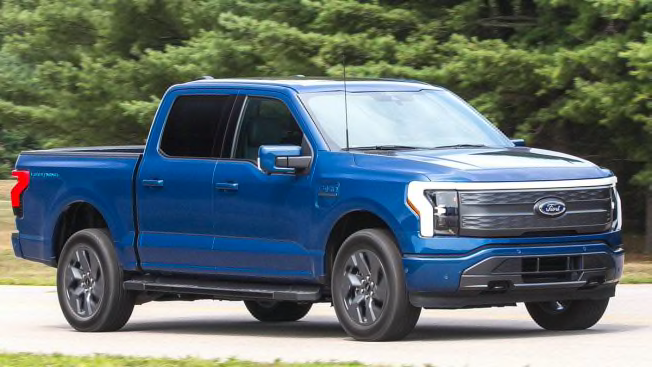
Photo: Consumer Reports Photo: Consumer Reports
The Trucks
Ford and Rivian offer multiple configurations of these trucks. We used the popularly equipped models that we had purchased for our test program.
Our F-150 Lightning Lariat ($80,889 as tested) is fitted with the extended-range battery, giving it an EPA range rating of 320 miles. It makes 580 hp and 775 lb.-ft. of torque. A smaller battery is available, and the top Platinum trim gets a slightly lower range rating. All Lightnings are crew cabs with a 5.5-foot bed and all-wheel drive.
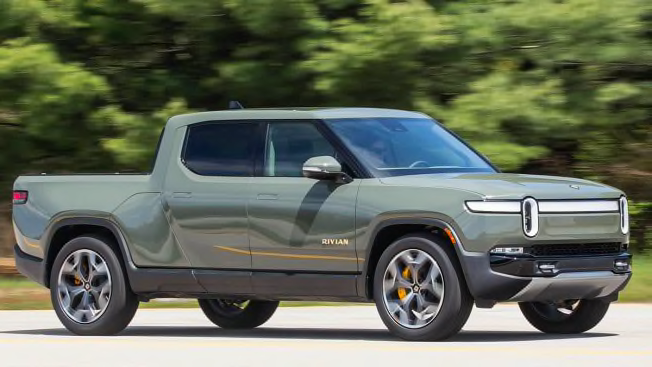
Photo: John Powers/Consumer Reports Photo: John Powers/Consumer Reports
Our R1T Launch Edition ($74,500 as tested) has quad-motor all-wheel drive, the large battery pack, and 21-inch all-season tires (as opposed to the available all-terrain tires). Power output is a prodigious 835 hp and stomach-twisting 908 lb.-ft. of torque. It manages 314 miles of range, according to the Environmental Protection Agency. Smaller and larger batteries are available, along with a dual-motor all-wheel-drive system and different wheel and tire packages, which all have influences on range.
How We Tested
We loaded an enclosed, double-axle aluminum trailer to just under 10,000 pounds, as weighed on a vehicle scale. That is near the maximum towing capacity for the Lightning and 1,000 pounds shy of the Rivian’s claimed limit. A load distributing hitch was used in each test. For reference, gas-powered F-150s are rated to tow anywhere between 5,000 and 14,000 pounds, depending on the configuration and options. (Learn more about towing.)
The EVs were charged to 100 percent before each test. The trucks sat overnight at a steady 68 degrees in our climate-controlled garage, minimizing the amount of battery charge spent warming them up on the day of the test. Each truck was driven by the same driver, who also does much of our fuel-economy testing and has a very precise foot, helping maintain consistency between runs. He drove at 65 mph without using cruise control when on the highway. The automatic climate control was set to 70 degrees in each vehicle.
Each truck was put into towing drive mode with trailer sway control enabled. We created a trailer “profile” within the F-150’s infotainment system, by entering information such as trailer type, weight, and length. This was not an option in the R1T at the time of testing.
Conditions: Testing took place on a clear day with temperatures ranging between 48 and 52 degrees and average wind speeds below 10 mph. (As we found in our previous range tests, a warmer day may have resulted in slightly more range, and freezing temps would have hurt the range.) The trucks were tested on the same day, in the same conditions, and on the same route for the most direct comparison possible.
Test loop: We chose a 74-mile loop starting from our test track in Connecticut, continuing onto CT Route 2, followed by a leg of I-395, and then turned back. This loop was chosen for its mostly flat terrain and lack of midday traffic that could make it difficult to maintain a steady speed on each run, potentially skewing the data. The short stretch of back roads leading to the highways, along with on- and off-ramps, gave us a chance to experience each truck’s lower-speed handling, acceleration, and braking performance while towing, in addition to highway cruising range.
Once back at our Auto Test Center, we didn’t just record the remaining range indicated in the trucks. We applied the ratio of miles of indicated range used vs. actual miles driven throughout the trip to extrapolate what would be the total real-world range for this specific trip if the trucks were driven to 0 percent battery state of charge.
We chose not to drain the trucks’ batteries to empty in order to reflect the typical owner experience. With the impact of towing on range, it’s a good idea to keep some energy in reserve to search for a charger, especially if you’re traveling with family on a busy weekend.
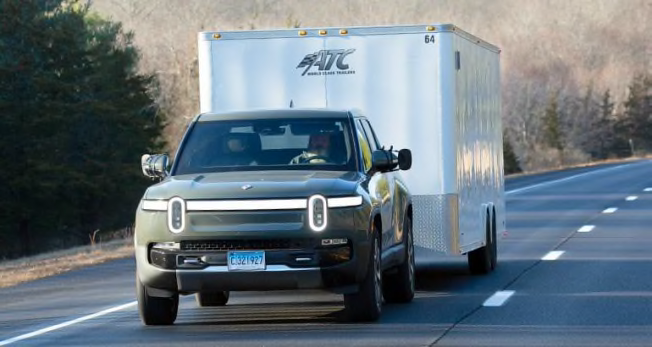
Photo: John Powers/Consumer Reports Photo: John Powers/Consumer Reports
What We Found
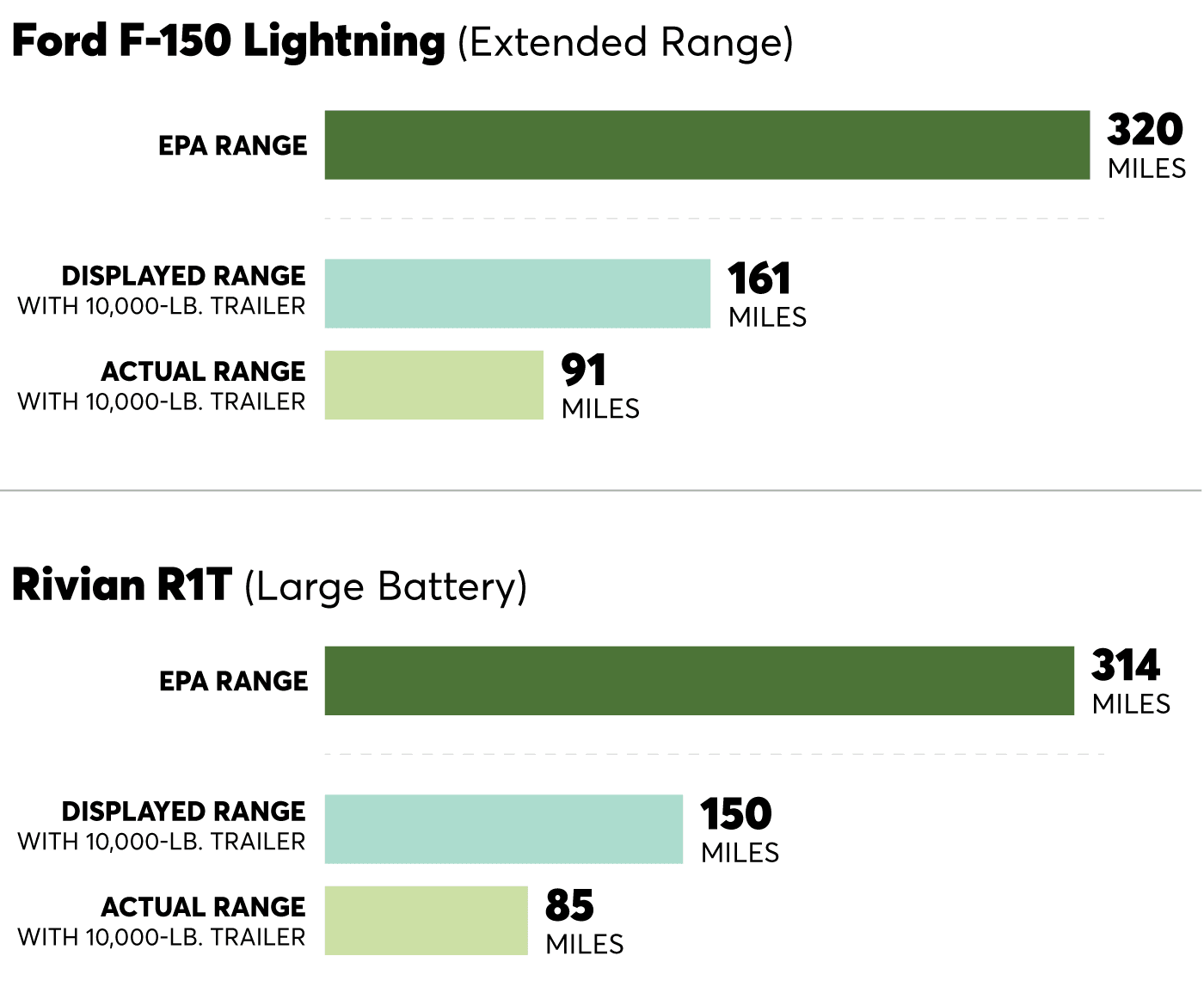

Range Prediction
EVs provide range predictions based on battery state-of-charge, driving habits over time, and other factors like climate settings and accessory use. Accuracy varies, but the onboard predictions give the driver a general idea of how far they can go. We took note of any adjustments the trucks made to their predictions when the trailer was first connected. Since fuel economy is reduced when towing with a gas truck, we would expect to see reduced range predictions in traditional trucks as well.
F-150 Lightning: The Lightning adjusted its range prediction to 161 miles and automatically engaged towing drive mode when the trailer was connected. Because we’d created a trailer profile by entering the weight and dimensions of the trailer into the Lightning’s infotainment system, we expected that it would have provided a more accurate prediction. Ford says that with a trailer connected, if a destination is entered in the navigation system, the range prediction will adjust based on the planned route.
Rivian R1T: Unlike the Lightning, the R1T doesn’t allow you to enter the weight and dimensions of the trailer. Even so, it adjusted its range prediction to 150 miles and automatically engaged towing drive mode when the trailer was connected.
Range
It’s no secret that towing a trailer will reduce an EV’s range, as it will with a gas-powered vehicle. We towed nearly 10,000 pounds to test Ford and Rivian’s max towing capacity claims, but also to evaluate range loss when towing at or near maximum rated capacity. Expect to see more range with a lighter and/or more aerodynamic load, such as when towing a small boat or a U-Haul trailer, when driving in similar conditions. In addition, colder temperatures would have negatively impacted range and efficiency even further. As always, range predictions and EPA ratings for any electric vehicle are moving targets depending on temperature, speed, load, climate, and traffic, among other factors.
Given the short ranges we experienced while towing, you may be forced to dip into uncomfortably low state of charge (SOC) just to make it to the next public charger while on a long trip.
F-150 Lightning: After 74 miles, the F-150 Lightning displayed 30 miles of range remaining and 27 percent battery SOC. An extra 52 miles of indicated range was consumed compared with the original prediction. Using this data, we extrapolated the theoretical maximum range for the Lightning in these conditions to be 91 miles—less than a third of the EPA rating.
Rivian R1T: The R1T fared similarly, with 20 miles remaining at 23 percent SOC and an additional loss of 56 miles compared with the initial prediction. The extrapolated maximum range for the R1T in these conditions was 85 miles—again, less than a third of the EPA range.
Electric Powertrain
Almost immediately we were impressed with how easily the EVs towed nearly 10,000 pounds. While there was no ignoring the extra weight, the low-end torque from the electric motors and direct-drive transmission made for effortless, smooth, and quiet acceleration in both trucks. Towing such a heavy load with a gas-powered truck typically results in a high-revving engine, noticeable gear changes, and a far less smooth experience overall. Regenerative braking and one-pedal driving were an unexpected delight while towing such a heavy trailer with both EVs, allowing for more seamless speed adjustments and an increased sense of control compared with our experiences towing with conventional trucks.
F-150 Lightning: Although the smoother and quieter of the two trucks, the Lightning wasn’t perfect. When accelerating quickly on an on-ramp, the reduced weight over the front wheels—combined with the high torque of the front motor—created a tugging force on the Lightning’s steering wheel, making the truck unruly and the driver feel unnerved.
Rivian R1T: While we had found in previous testing that the R1T’s regenerative braking tuning makes for a jerky experience during normal driving, towing the trailer smoothed the system out beautifully. We did not experience any unexpected tugging force at the Rivian’s steering wheel as we did in the Lightning.
Handling Dynamics
Handling was very similar between the two trucks when driving on slower back roads, where you’re more concerned about avoiding telephone poles and your neighbor’s mailbox than cornering speed. But at 65 mph, the differences began to show.
F-150 Lightning: The Lightning has fully independent suspension, a first for any F-150, but its traditional springs and shocks are not able to make any adjustments to counteract the trailer weight. As a result, the Lightning’s steering felt shockingly light and vague on the highway, requiring constant corrections by the driver. Typically, a traditional solid rear axle is more desirable for heavy towing.
Adding to the anxiety, the truck’s sway control appeared to be making constant adjustments of its own to keep the Lightning stable within the lane. If the reduced range didn’t already have you making frequent stops, this nerve-wracking experience might.
While we were driving, we noticed the hands-free BlueCruise icon in the gauge cluster display and we activated the system, despite that the owner’s manual warns not to use the system while towing. We tried it briefly, and it was a white-knuckle experience, with the truck and trailer swaying. Shortly after, the system shut itself off. Ford advises that BlueCruise does operate in hands-on mode when towing, but we think it would be better if BlueCruise was disabled entirely when the Lightning detects a connected trailer.
On a positive note, a heavier vehicle tends to aid in overall stability. The Lightning weighs in at 6,790, which is almost 1,000 pounds heavier than the F-150 Hybrid we recently tested. So when the road is straight and flat, the Lightning’s mass helps dampen the weight and motions of the trailer.
Rivian R1T: The Rivian also has fully independent suspension but with the addition of air springs, adjustable dampers, and a hydraulic roll stabilization system. Despite its 10-inch shorter wheelbase and slightly narrower width, the Rivian was more stable than the Lightning while cruising, making the driver more comfortable and confident. It is heavier than the Lightning at 6,925 pounds, but technology is the key here: The air springs are able to fill up to compensate for the added weight on the hitch and keep the body level, while the adaptive dampers and hydraulic roll system work together to further stabilize the vehicle.
Charging
Access to public charging stations is a critical consideration for any EV driver on a long trip, but it becomes an even greater limiting factor if you’re also towing—especially with the large battery packs in trucks. You can forget about slower Level 2 charging stations and expect to become well acquainted with Level 3 DC fast charging and route planning; it will be the only way to reach far destinations as long as you’re not in a hurry, with the frequency of stops that will be required.
In addition to the stark reality of arriving at potentially inoperable chargers with few miles of range remaining, most charge locations are not pull-through designs like typical gas stations. With chargers often located against curbs and at the back of parking lots, it can be a challenge to park the truck and trailer without blocking and inconveniencing other drivers. This is especially true if there is a line for the chargers. At worst you may be forced to disconnect the trailer before charging.
The reliance on DC fast charging brings other complications, too. A common strategy among EV road trippers is to stop and charge more frequently but maintain a level of charge between about 20 and 80 percent. They do this because charging rates tend to slow dramatically after the battery gets to 80 percent SOC, often making it not worth time for the extra 20 percent. But with only around 100 miles of range, you may not have that luxury. Ford says the Lightning can charge between 15 and 80 percent in as little as 41 minutes. But waiting for a full charge could add an additional 30 minutes or more depending on the vehicle and charger. This means you’ll need to add significant time to your journey. Plus, the high rate of discharge while towing and repeated use of DC fast charging may also impact the long-term health of a battery pack.
Trailering Logistics
Somewhat surprisingly, we had to buy aftermarket mirror extensions for the Lightning and R1T, because towing mirrors are not offered from the factory on either truck. This seemed like a crude compromise on such advanced vehicles.
The Lightning has the same hitch setup as any other F-150, with the receiver exposed and easily accessible under the rear bumper. Rivian hides the hitch under an aesthetic plastic cover. We had to crawl underneath to undo fasteners to expose the hitch.
Should You Tow With Your Electric Pickup?
As capable and smooth as the EVs are, they simply cannot match the heavy long-distance towing capabilities of gas, hybrid, and diesel-powered trucks. This is primarily due to the severely limited range, and the amount of time that would be required for charging during the trip. Accessing a public charger with a trailer in tow also presents potentially significant logistical challenges.
That said, they can be a good option for towing small trailers short distances. The torque and near-instant response of a powerful electric drivetrain makes for a smooth, quiet, and more effortless experience compared with gasoline- and diesel-powered trucks. The Rivian R1T stood out in particular for its stability and driver confidence during highway cruising. But that has less to do with it being an EV and more about its sophisticated suspension.
















